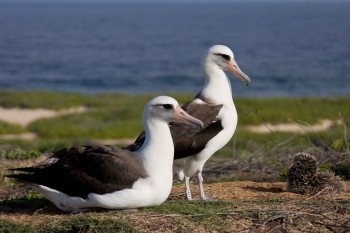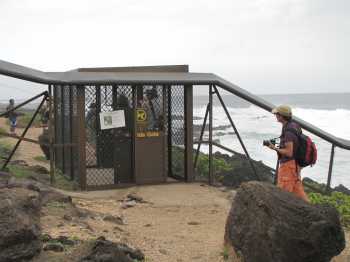Lindsay Young (Pacific Rim Conservation, Honolulu, USA) and colleagues, writing in the journal Biological Invasions, report on the success achieved with protecting a Hawaiian colony of Laysan Albatrosses Phoebastria immutabilis and Wedge-tailed Shearwaters Puffinus pacificus from introduced mammalian predators.
The paper’s abstract follows:
“Ka‘ena Point Natural Area Reserve on O‘ahu hosts one of the largest seabird colonies in the main Hawaiian Islands and supports three species of endangered plants. In order to stop chronic predation by invasive alien mammals on native species, a peninsula-style predator-proof fence was constructed around a 20-ha portion of the reserve in 2011. Multi-species predator removal efforts began upon fence completion; diphacinone poison in bait boxes spaced 25 m apart was used to remove black rats, house mice, and small Indian mongooses. House mice also were removed with multiple-catch live traps spaced 12.5 m apart. Feral cats were removed with padded leg-hold traps. Feral cats and mongooses were eradicated in 1 month, black rats were eradicated in 2.5 months, and house mice were eradicated in about 9 months. Since eradication, incursions of cats and mongoose have been rare (1/7.2 months), but incursion frequency has been higher for black rats (1/56 days) and house mice (1/36–47 days). Buffer predator control was conducted to limit predator access and prevent reinvasion around the fence ends along the shoreline. Even with the high initial fence cost and ongoing predator incursion management, this method is expected to become more cost effective than previous predator control efforts after 16 years. Record numbers of Wedge-tailed shearwaters and Laysan albatrosses have fledged from the reserve after predator eradication, and regeneration of native plants and invertebrates is being observed. With careful planning and persistence, predator fences can be a cost-effective method of protecting natural resources, and multiple species of predators can be eradicated with traps and first-generation anti-coagulents.”

Laysan Albatrosses at Ka'ena Point. Photograph by Lindsay Young

Entrance gate and fence, Ka'ena Point. Photograph by John Cooper
Click here to read a short review of how predator-proof fences are protecting albatrosses, petrels and shearwaters around the World.
Selected References:
Young, L.C., VanderWerf, E.A., Lohr, M.T., Miller, C.J., Titmus, A.J., Peters, D. & Wilson, L. 2013. Multi-species predator eradication within a predator-proof fence at Ka‘ena Point, Hawai‘i. Biological Invasions DOI 10.1007/s10530-013-0479-y.
Young, L.C., VanderWerf, E.A., Mitchell, C., Yuen, E., Miller, C.J., Smith, D.G. & Swenson, C. 2012. The Use of Predator Proof Fencing as a Management Tool in the Hawaiian Islands: a Case Study of Ka`ena Point Natural Area Reserve. Technical Report No. 180. Honolulu: The Hawai`i-Pacific Islands Cooperative Ecosystem Studies Unit & Pacific Cooperative Studies Unit, University of Hawai`i. 82 pp.
John Cooper, ACAP Information Officer, 9 June 2013

 English
English  Français
Français  Español
Español